OCZ ARC 100 Series SSDs are designed for mainstream consumers who want the benefits of flash storage without a big price tag; the ARC 100 gives consumers an aggressive suggested price point of .50/GB. Of course as the SSDs get into retail, pricing will fall even further. OCZ doesn’t cut corners though with the ARC 100, part of the pricing power is due to the vertical integration with parent company Toshiba. Jointly they own all of the core components in the drive, including the controller and Toshiba MLC NAND. The ARC 100 offers a good endurance profile, supporting 20GB of writes per day (same as the Vertex 3) and the drives come with a three-year warranty.
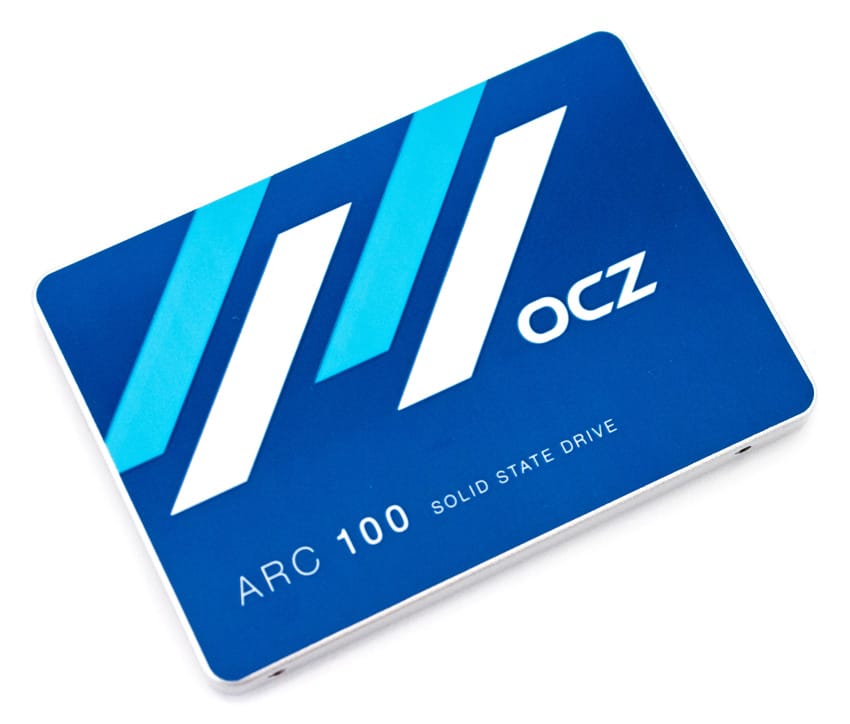
Looking deeper into its specs, the ARC 100 Series is the first OCZ drive to use Toshiba’s next generation A19nm NAND flash and features an in-house OCZ Barefoot 3 M10 controller and firmware. The body is an ultra slim 2.5-inch 7mm form factor that will fit almost any notebook; OCZ does not include a 3.5″ bracket with this drive. OCZ quotes read and write speeds up to 490MB/s and 450MB/s respectively for the 480GB capacity as well as random read and write throughout of 75,000 IOPS and 80,000 IOPS.
All ARC 100 SSDs ship with OCZ’s new ShieldPlus Warranty, which is designed to eliminate most of the hassle that consumers have to deal with when it comes to support and warranty claims. OCZ’s ShieldPlus Warranty requires no original proof of purchase; end-users simply need their ARC 100 SSD serial number and a customer service representative will provide troubleshooting and support. If it is deemed to be defective, a brand-new SSD will be shipped to the customer along with a pre-paid return label so users can return the original, defective drive for free.
The OCZ ARC 100 Series SSDs come in capacities of 120GB, 240GB, and 480GB and are priced at $75, $120, and $240 respectively. We will be looking at the 240GB unit for this review.
OCZ ARC 100 Series SSD Specifications
- Capacities
- 120GB
- 240GB
- 480GB
- Performance:
- Max Read: 475MB/s (120GB), 480MB/s (240GB), 490MB/s (480GB)
- Max Write: 395MB/s (120GB), 430MB/s (240GB), 450MB/s (480GB)
- Max Random Read IOPS (4K QD32): 75,000
- Max Random Write IOPS (4K QD32): 80,000
- Steady-State Random Write IOPS (4K QD32): 12,000 (120GB), 18,000 (240GB), 20,000 (480GB)
- Controller: OCZ Barefoot 3 M10
- NAND Components: A19nm Toshiba Multi-Level Cell (MLC) Flash
- Interface: SATA III 6Gb/s
- Form Factor: 2.5-inch (100.2 x 69.75 x 6.7 mm)
- Encryption: 256-bit AES-compliant
- Data Path Protection: BCH ECC corrects up to 44 random bits/1KB
- Product Health Monitoring: Self-Monitoring, Analysis and Reporting Technology (SMART)
- Power Consumption:
- Idle: 0.6W
- Active: 3.45W
- Operating Temperature: 0°C ~ 70°C
- Shock Resistance: 1000G/0.5ms
- Vibration (Operational): 2.17Grms (7-800Hz)
- Vibration (Non-operational): 3.13Grms (5-800Hz)
Design and Build
The ARC 100 consists of an all-alloy build in an ultra slim form factor. The design of OCZ ARC 100 Series SSD is different from that of its predecessors with its all new blue and white color scheme (as opposed to the Vector 150‘s black, white and blue design). The front side has a very appealing look due to its minimalistic appearance, which only includes the name of the drive.
The backside has a standard information label, providing users with everything they need to know about the ARC 100, including serial numbers, model, PNs, and so on.
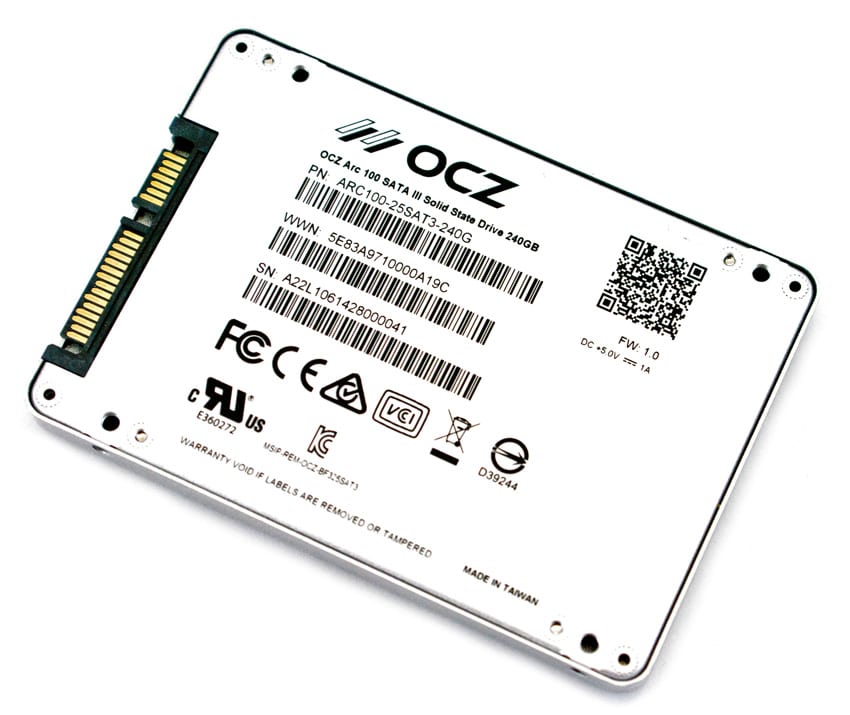
Each side of the drive has two screw holes for easy mounting as well.
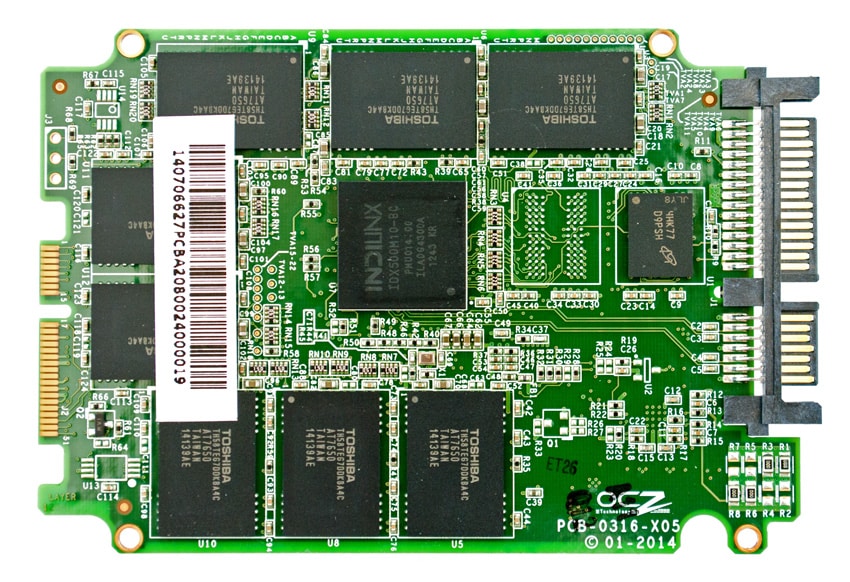
Its 7mm 2.5-inch form-factor allows the ARC 100 to be compatible inside virtually any type of platform; such as ultrabooks and embedded solutions. The front of the SSD has a standard SATA power and data interface.
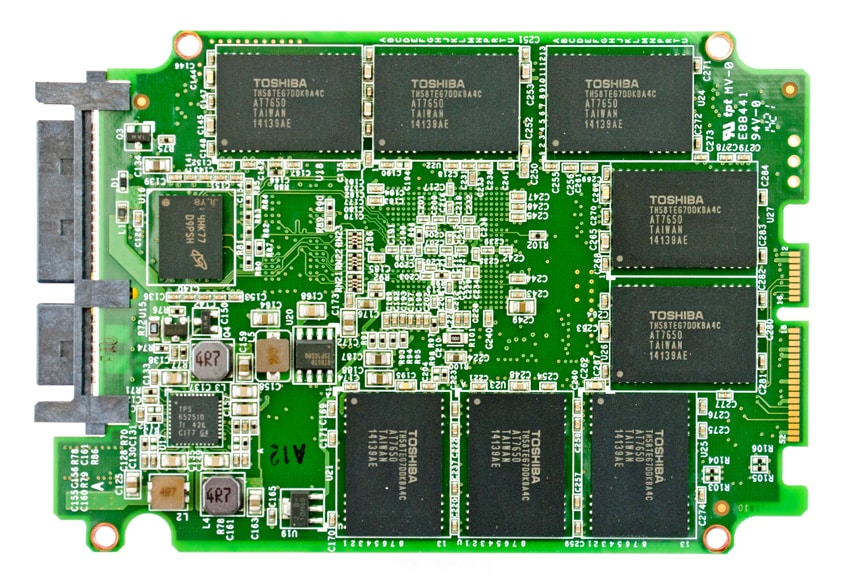
Once you open up the drive via the four Phillips head screws, you will see the OCZ Barefoot 3 M10 controller and Toshiba A19nm MLC NAND at the heart of the ARC 100.
Consumer Synthetic Benchmarks
All consumer SSD benchmarks are conducted with the StorageReview Consumer Testing Platform. The comparables used for the OCZ ARC 100 Series SSD review include:
- Samsung SSD EVO 250GB (Samsung MEX controller, 19nm Samsung TLC NAND, SATA)
- Crucial M500 480GB (Micron 20nm MLC NAND Flash, Marvell 9187 controller, SATA)
- OCZ Vertex 460 240GB (Toshiba 19nm MLC Flash NAND, Barefoot 3 M10 controller SATA)
- Crucial/Micron M550 512GB (20nm 64Gb/128Gb MLC NAND, Marvell 88SS9189, SATA)
- Corsair Force LX 256GB (28Gbit Micron 20nm ONFI MLC NAND, Silicon Motion SM2246EN controller, SATA)
- Corsair Force LS 240GB (19nm Toshiba MLC NAND, Phison PS3108 controller, SATA)
- Crucial MX100 512GB (Micron 20nm MLC NAND, Marvell 88SS9189 controller, SATA)
All IOMeter figures are represented as binary figures for MB/s speeds.
In our first test measuring 2MB sequential performance, the OCZ ARC 100 posted 448.7MB/s read and 392.0MB/s write, which ranks near the back.
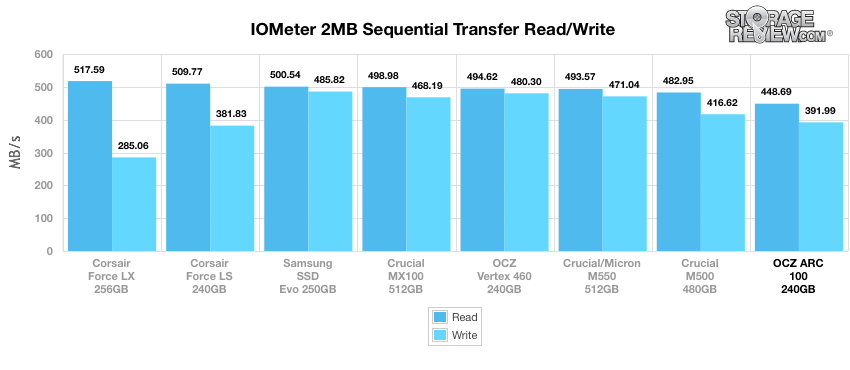
Our next test looks at 2MB random transfer performance. Here, the OCZ ARC 100 scored 397.6MB/s read and 390MB/s write, ranking at the bottom and middle, respectively, among its comparables.
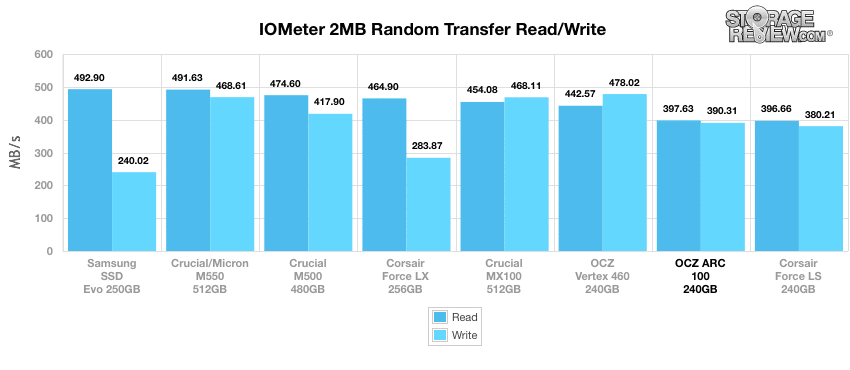
When moving on to our smaller 4K random transfers test, the OCZ ARC 100 measured 6,661 IOPS read at QD1, which ranked near the middle of the standing as well as a write speed of 21,979 IOPS, which was 2nd among our rankings.
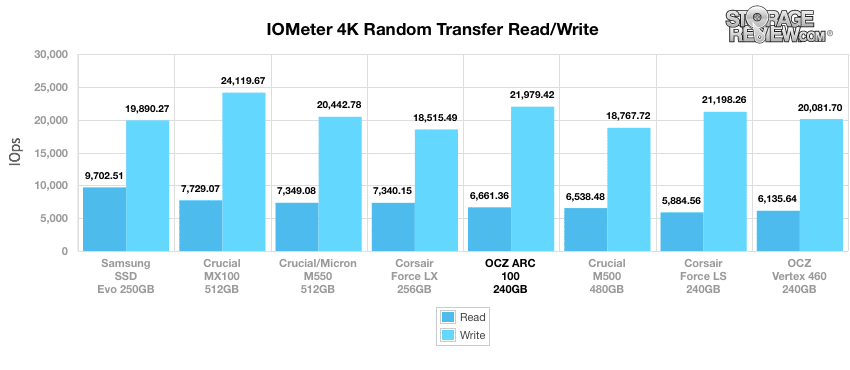
In our next test, we shift to a workload with 100% write activity that scales from 1QD to 64QD. In this setting, the OCZ ARC 100 scaled from 19,792 IOPS up to 80,885 IOPS.
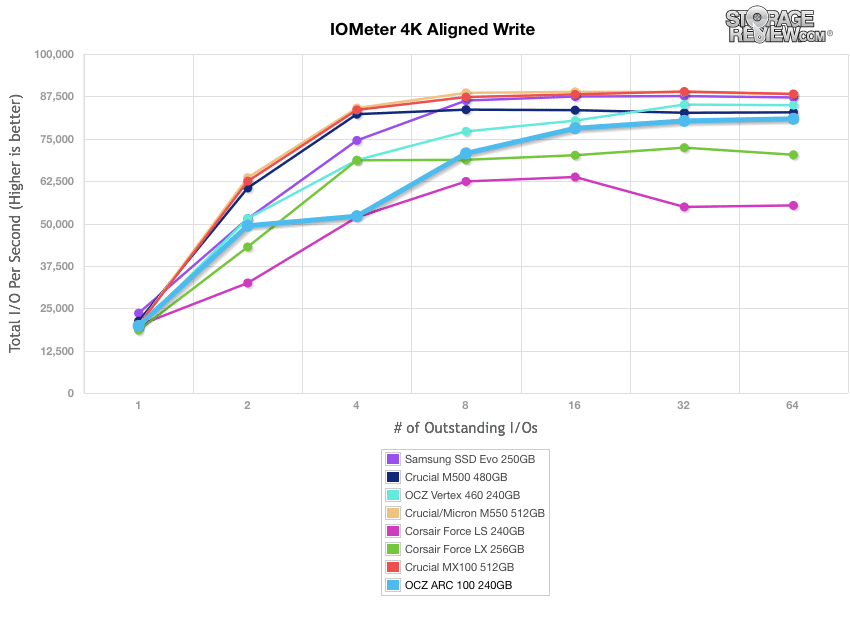
Moving to read activity, the OCZ ARC 100 posted a 1QD of 6,637 IOPS and up to 81,985 IOPS at 64QD.
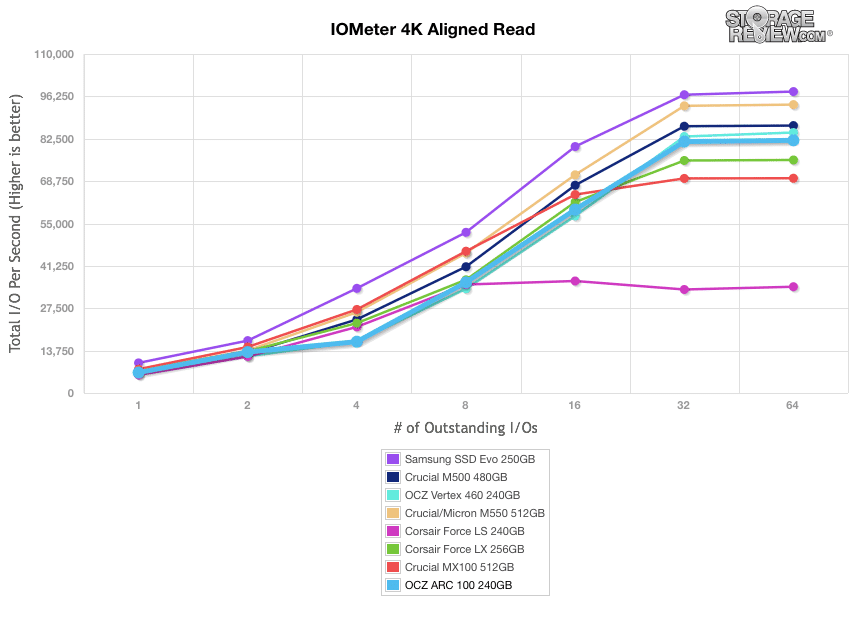
Next, we compare the ARC 100’s average write latency to each mainstream/value consumer SSD. Here it placed very well among the comparables with an average latency of 0.045ms and a fairly low peak latency of 2.76ms.
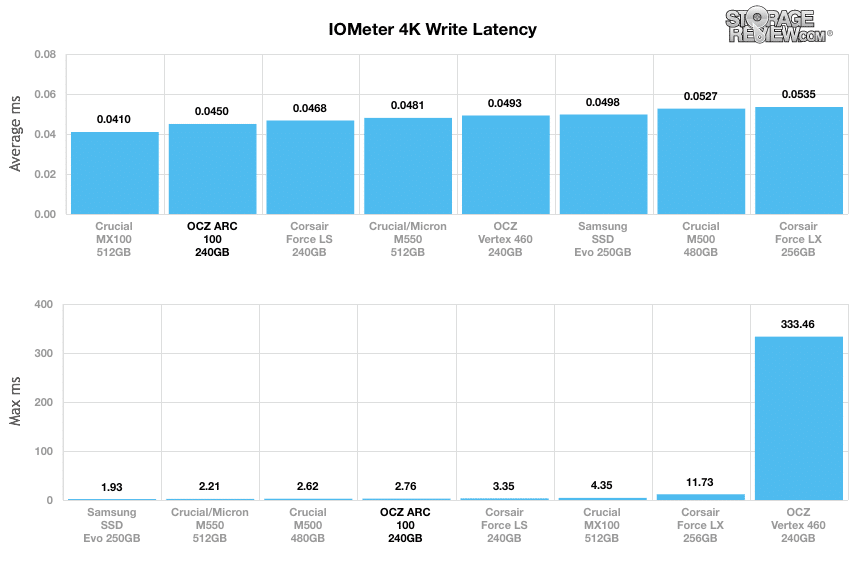
Our last series of synthetic benchmarks compare the hard drives in a series of server mixed-workloads with a queue depth of ranging from 1 to 128. Each of our server profile tests has a strong preference towards read activity, ranging from 67% read with our database profile to 100% read in our web server profile.
The first is our database profile, which consists of a 67% read and 33% write workload mix primarily centered on 8K transfer sizes. The OCZ ARC 100 posted a QD1 of 6697IOPS with a QD128 41301 IOPS, ranking in the near the top of the pack.
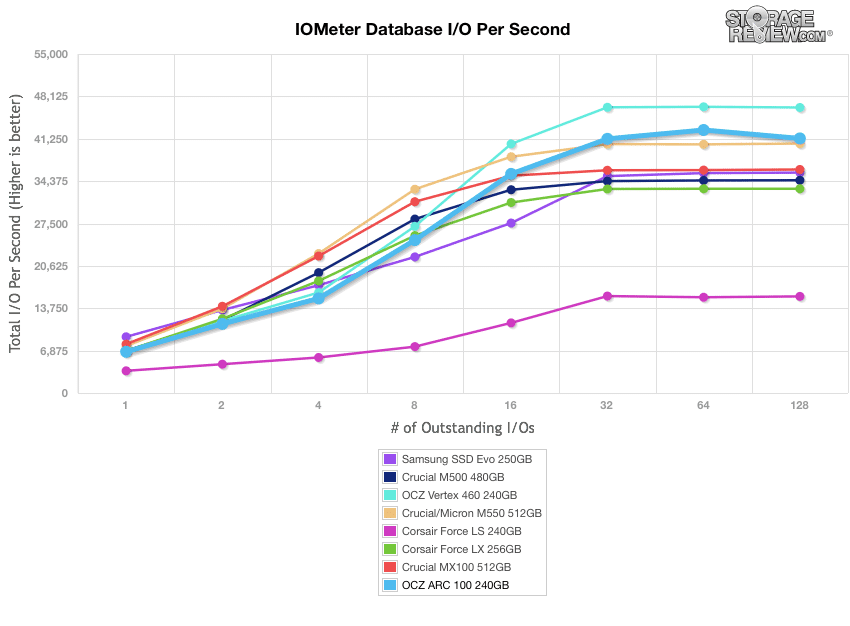
In our a file server, which has a 80% read and 20% write workload spread out over multiple transfer sizes ranging from 512-byte to 64KB, the OCZ ARC 100 came in 3rd place.
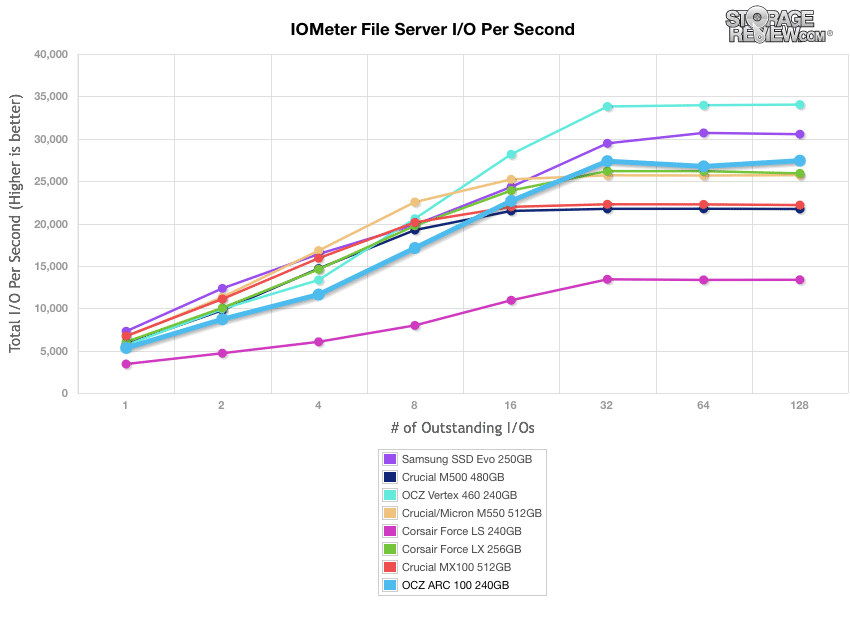
Our web server profile is read-only with a spread of transfer sizes from 512-byte to 512KB. Here, the OCZ ARC 100 took 3rd place again.
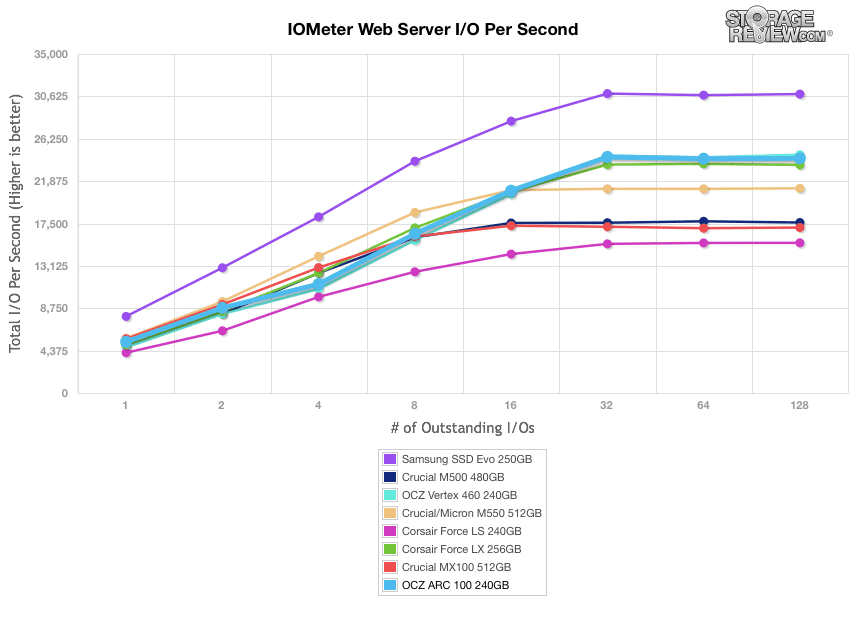
The last profile looks at workstation activity, with a 20% write and 80% read mixture using 8K transfers. The OCZ ARC 100 continued to fair very well, placing near the top of the leaderboard with 44,328 IOPS at QD128.
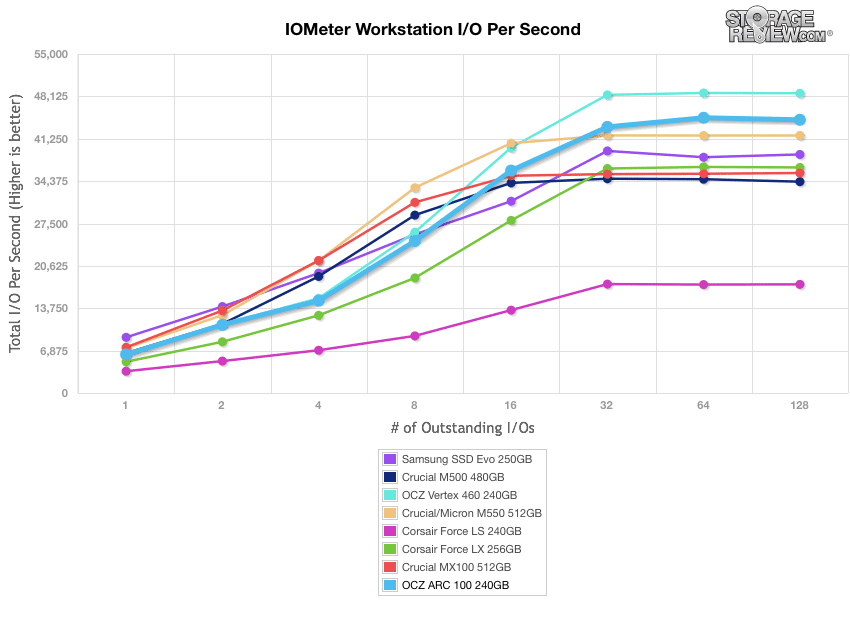
Consumer Real-World Benchmarks
For the average consumer, trying to translate random 4K write speeds into an everyday situation is pretty difficult. It helps when comparing drives in every setting possible, but it doesn’t exactly work out into faster everyday usage or better game loading times. For this reason we turned to our StorageMark 2010 traces, which include HTPC, Productivity, and Gaming traces to help readers find out how a drive might rank under their conditions.
The first real-life test is our HTPC scenario. In this test we include: playing one 720p HD movie in Media Player Classic, one 480p SD movie playing in VLC, three movies downloading simultaneously through iTunes, and one 1080i HDTV stream being recorded through Windows Media Center over a 15 minute period. Higher IOps and MB/s rates with lower latency times are preferred. In this trace we recorded 2,986MB being written to the drive and 1,924MB being read.
In our HTPC profile, the OCZ ARC 100 offered performance at the bottom of the pack, with an average speed of 217.3MB/s, 4,685 IOPS and an average latency of 1.65ms.
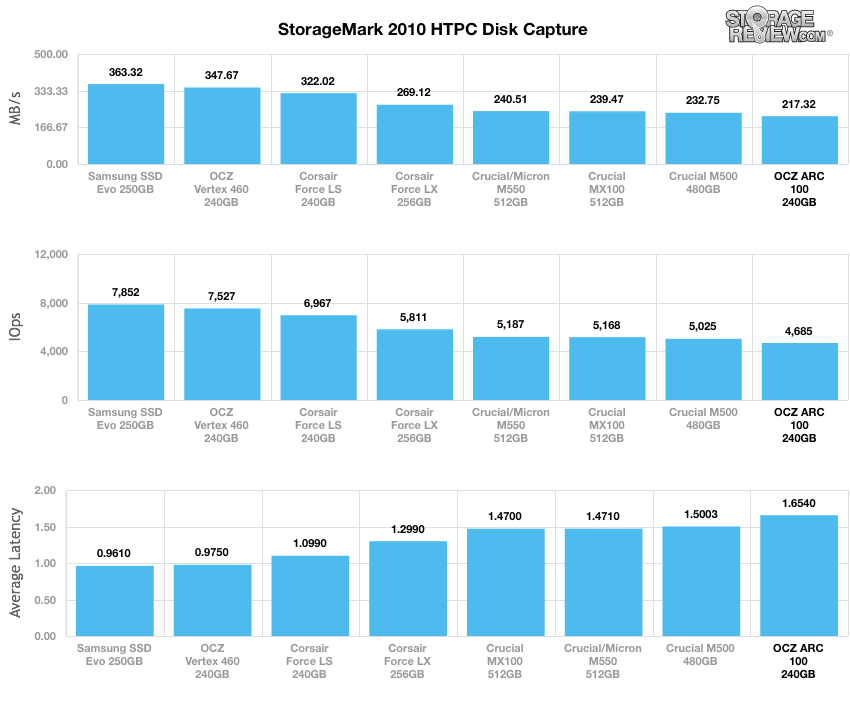
Our second real-life test covers disk activity in a productivity scenario. For all intents and purposes this test shows drive performance under normal daily activity for most users. This test includes: a three hour period operating in an office productivity environment with 32-bit Vista running Outlook 2007 connected to an Exchange server, web browsing using Chrome and IE8, editing files within Office 2007, viewing PDFs in Adobe Reader, and an hour of local music playback with two hours of additional online music via Pandora. In this trace we recorded 4,830MB being written to the drive and 2,758MB being read.
In our Productivity trace, though it showed a slight improvement, the OCZ ARC 100 posted sub-par results with an average speed of 139.0MB/s and IOPS of 4,745.
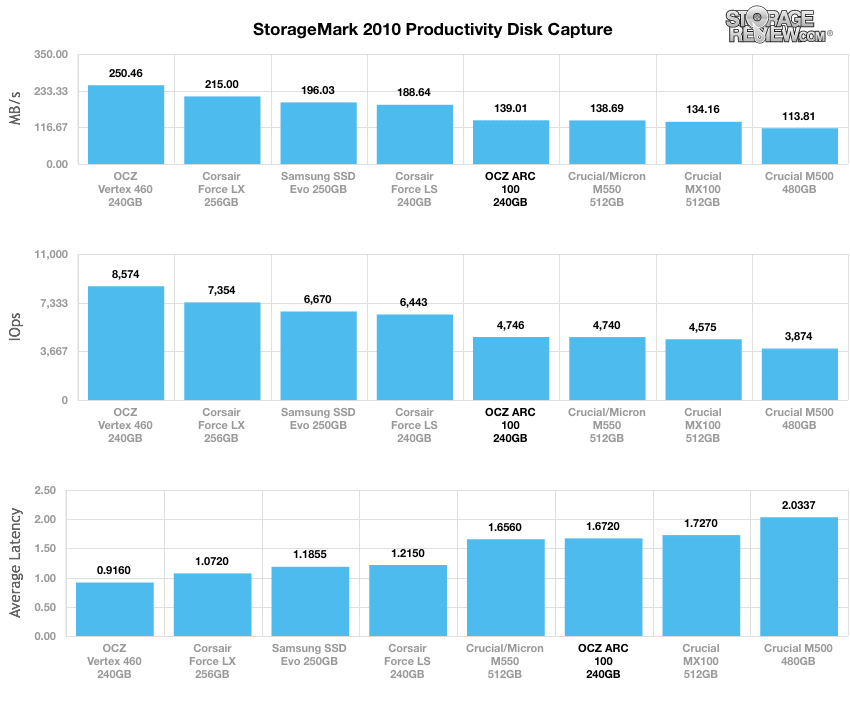
Our third real-life test covers disk activity in a gaming environment. Unlike the HTPC or Productivity trace, this one relies heavily on the read performance of a drive. To give a simple breakdown of read/write percentages, the HTPC test is 64% write, 36% read, the Productivity test is 59% write and 41% read, while the gaming trace is 6% write and 94% read. The test consists of a Windows 7 Ultimate 64-bit system pre-configured with Steam, with Grand Theft Auto 4, Left 4 Dead 2, and Mass Effect 2 already downloaded and installed. The trace captures the heavy read activity of each game loading from the start, as well as textures as the game progresses. In this trace we recorded 426MB being written to the drive and 7,235MB being read.
In our read-intensive Gaming trace, the OCZ ARC performed similar to the other profiles with a speed of 430MB/s.
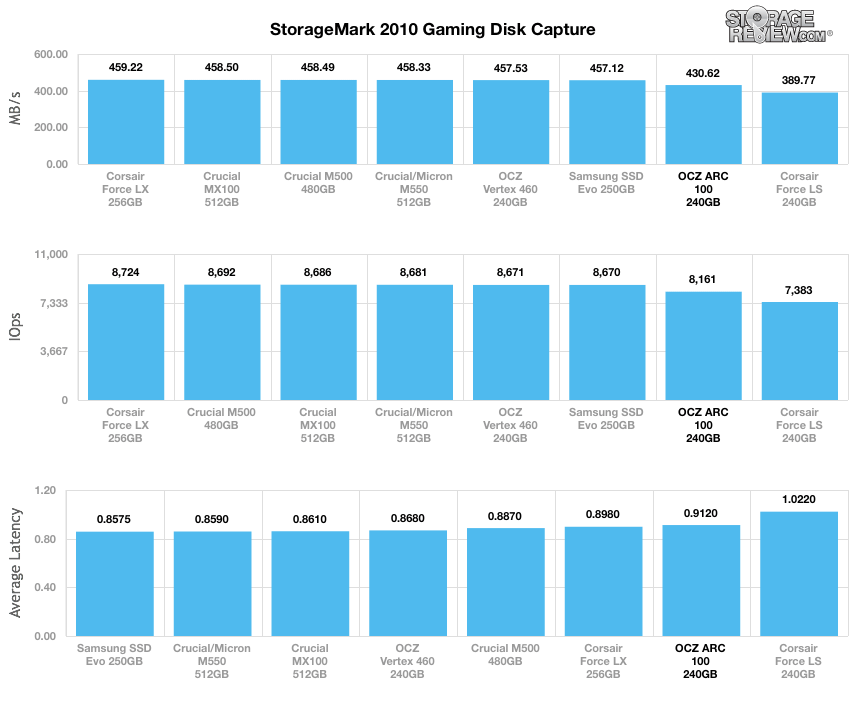
Power Consumption
Low idle power consumption is very important when it comes to SSD power management, as consumer-grade SSDs spend much of time in an idle state. The ARC 100 is quoted by OCZ as having an idle reading of 0.6W and an active consumption of 3.45W.
In our tests, we measured idle power consumption from the OCZ ARC 100 at 0.61 watts, with a highest measured total at 3.35 watts, which took place during write activity. These readings were in-line to what OCZ quoted.
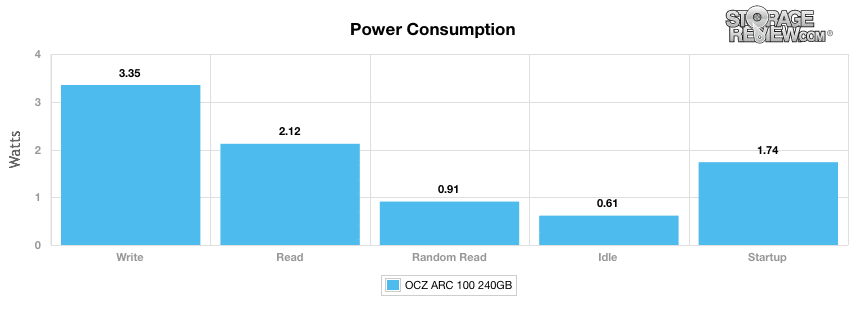
Conclusion
The OCZ ARC 100 is designed for mainstream consumers looking to gain all the benefits of flash storage with a value-oriented SSD. It is equipped with SATA 6Gb/s, the OCZ Barefoot 3 M10SS9189 controller, and is the first OCZ drive to feature Toshiba’s A19nm MLC Flash. Its ultra slim 2.5-inch, 7mm form factor allows it to fit in virtually any type of device as well as its competitive pricing make it a compelling choice for anyone who’s looking to upgrade from an HDD-based system to a solid-state rig.
As far as performance goes, the OCZ ARC 100 posted mixed results throughout our tested categories, though this was expected for this class of SSD. In our consumer workloads, it generally performed below par when it came to our single 4K and 2MB transfer benchmarks; however, it picked up in our 100% read/write-intensive tests. When we put it through our synthetic workloads, the OCZ ARC 100 performed much better, placing among the top three drives in each of our profiles. The consumer real-world benchmarks is where it showed the weakest performance of our gauntlet of tests, posting results that placed the drive at the bottom of the pack in all three profiles; sometimes by a noticeable margin.
When it comes down to it however, the performance of the ARC 100 are well in line with its affordable price and target demographic and OCZ was clear and up front as to where it fits in the SSD market. You really can’t go wrong with its $75, $120, and $240 price tag for the 120GB, 240GB, 480GB respectively, which is a $0.50/GB ratio for the two highest capacities. And that’s just the starting point, as these drives get into market, the price will come down even further, making the OCZ drive a viable option in the congested value market. For those considering moving from an HDD, the ARC 100 will still offer night and day performance gains to go with power savings and the other classic SSD benefits. The drive also comes with the new no-nonsense ShieldPlus Warranty plan, making it easy to own as well.
Pros
- Competitively priced
- Great warranty program
- Vertically integrated solution
Cons
- Mixed performance
Bottom Line
The OCZ ARC 100 offers the benefits of an SSD with an aggressive price point making it an attractive option for mainstream users looking to upgrade an HDD-based system.
OCZ ARC 100 at Amazon



 Amazon
Amazon